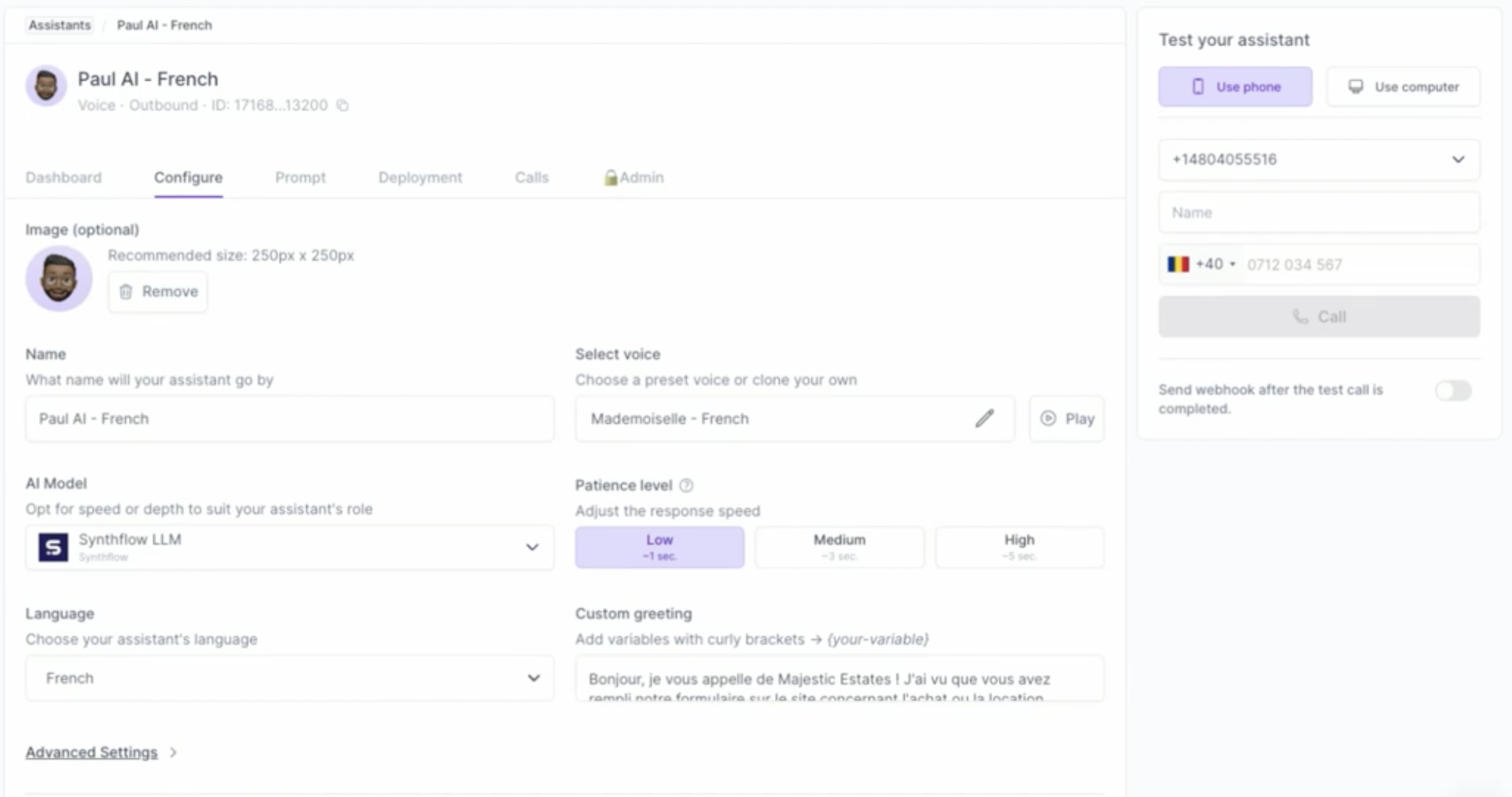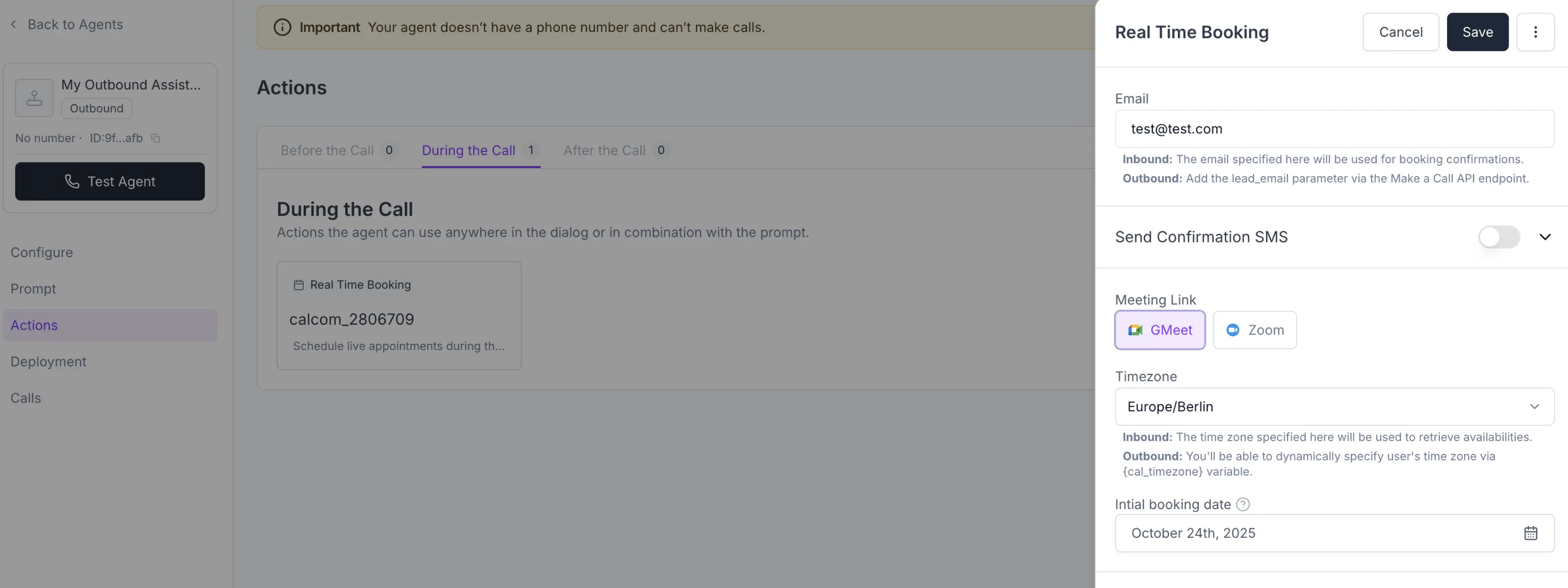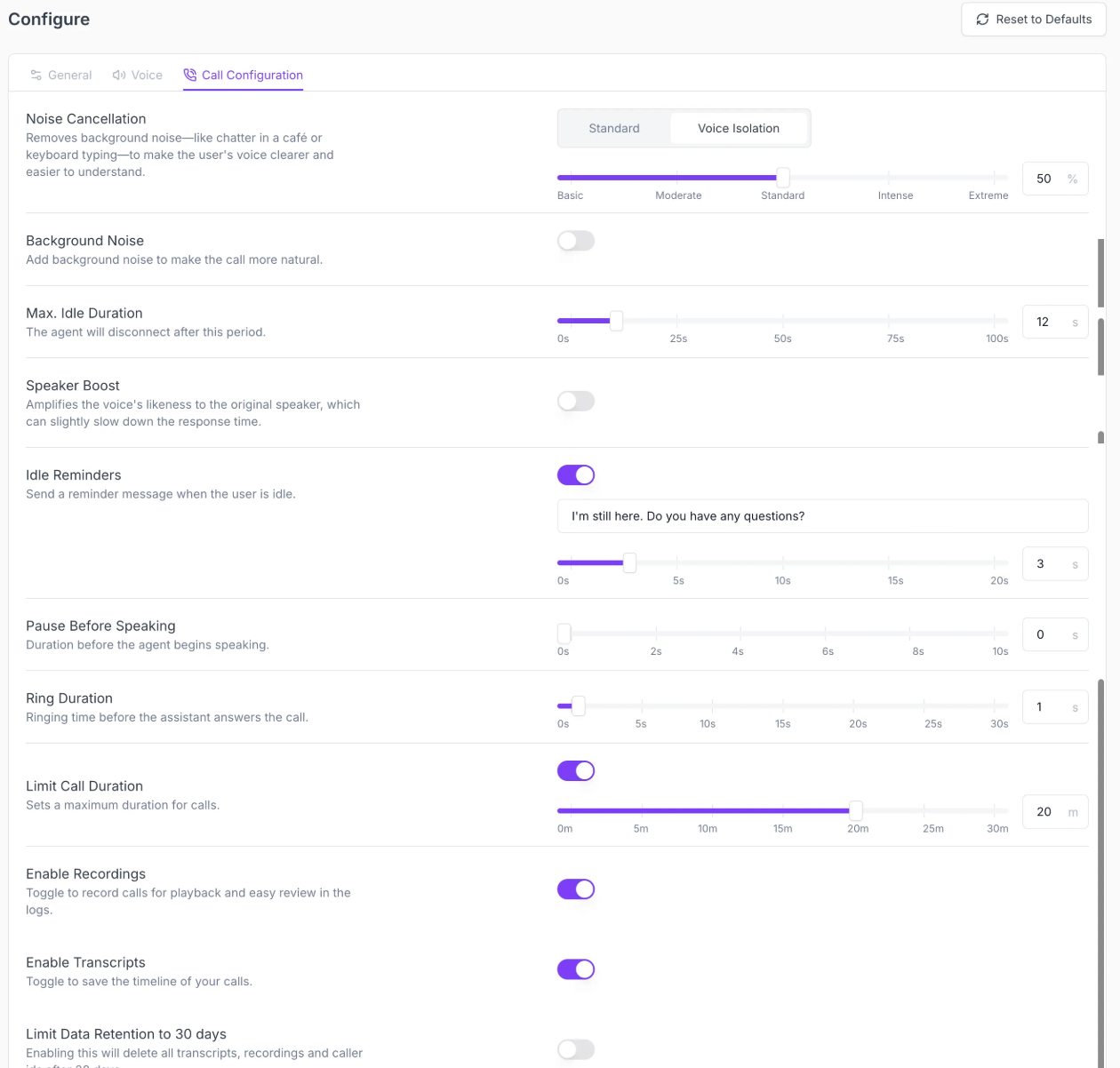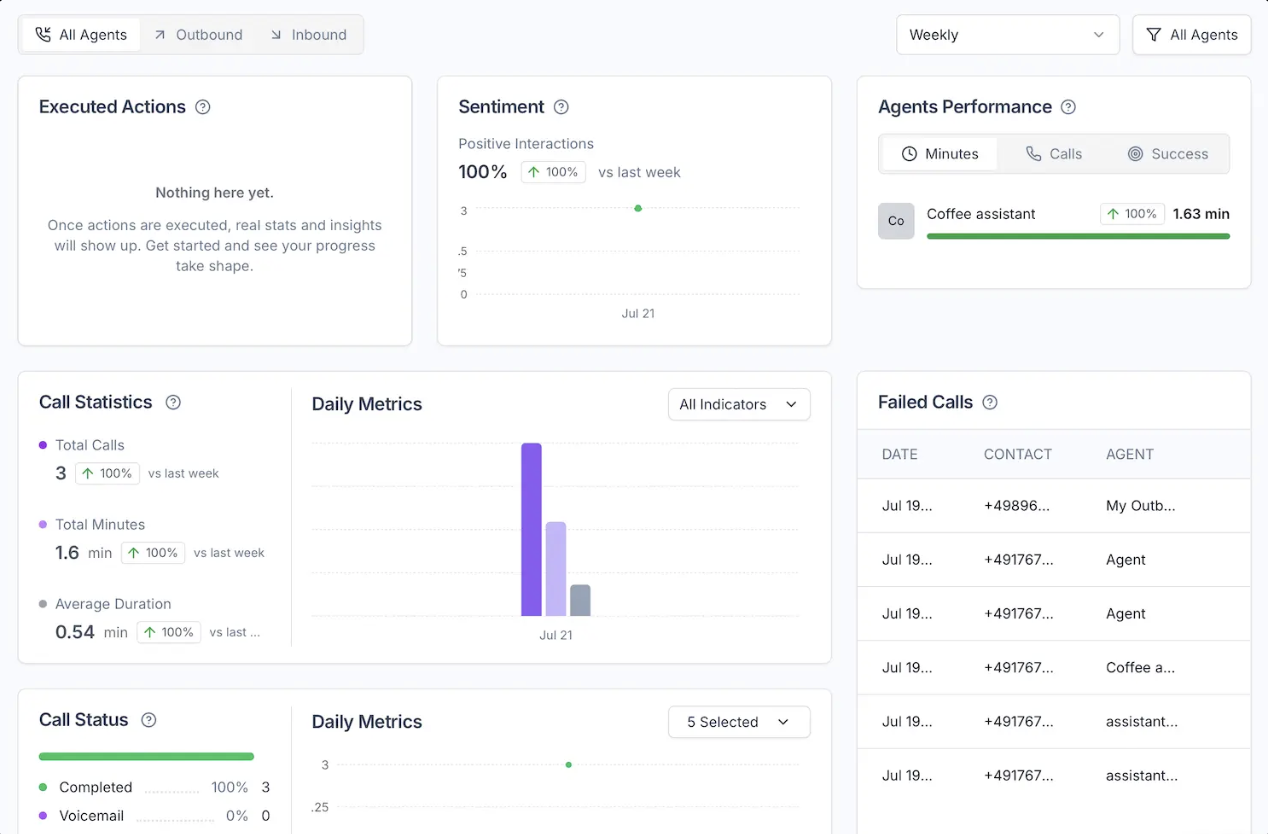As artificial intelligence rapidly expands into nearly every market and aspect of our lives, we are seeing the most popular business communication providers integrating proprietary AI receptionists into their tech stacks.
AI Receptionists are virtual agents that enable companies to reduce the number of interactions going to live human agents- sometimes drastically. But not every company needs a full service UCaaS platform with hundreds of features, a steep learning curve, and an expensive price tag. This is where standalone AI Receptionist platforms like Synthflow come in.
Read on to find out how Synthflow AI Receptionist works, what features it offers, and how it compares to other AI Receptionists.
What is Synthflow AI Receptionist?
Synthflow is a standalone AI Receptionist that syncs up with your company’s business communication system and CRM to provide 24/7 conversational AI voice service to customers and text/SMS service via WhatsApp.
Synthflow AI agents are able to answer calls, field common questions, book meetings, transfer calls, and more. Synthflow can handle over 100 calls at the same time and AI agents can speak in over 20 different languages.
Pricing and Plans
Synthflow also offers four subscription plans. The Pro plan costs $375/month and includes 2,000 minutes/month. The Growth plan costs $750/month and includes 4,000 minutes/month. And the Agency plan costs $1,250/month and includes 6,000 minutes/month.
There is also a quote-based Enterprise plan. Additional minutes cost $0.12-$0.13/minute depending on the plan. Additional concurrent calls cost $7/call.
Key Features of Synthflow AI Receptionist
All AI Receptionists are able to answer and route calls along with performing simple processes and answering FAQs, but Synthflow offers some unique benefits. Here are some of the features that help Synthflow AI Receptionists stand out.
Multilingual Voice Agents

Most AI Receptionists only speak English and Spanish, and even larger SaaS platforms like GoTo Connect offer 10 languages. Sythflow surpasses them all with over 20 language options for AI Receptionists.
Synthflow users can also choose between three different English accents- American, British, and Australian. The multilingual AI Receptionist will switch seamlessly between English, Spanish, French, German, Hindi, Russian, Portuguese, Japanese, Italian, and Dutch.
Other languages offered include: Greek, Polish, Swedish, Norwegian, Danish, Finnish, Romanian, Bulgarian, Czech, Slovak, Ukranian, Turkish, Mandarin, Korean, Malay, Hindi, Thai, Vietnamese, Indonesian.
Pre-Built Templates

Synthflow AI agents are able to do more than just answer the phone and take a message, they can perform a number of repetitive tasks, saving companies both time and money. Admins start with pre-built templates, add custom actions, and create dynamic workflows and automations.
Synthflow templates include:
- Buying appointment scheduler
- Customer support
- Event demand generator
- Claims receptionist
- Appointment reminder
- Lead qualification
Custom actions include:
- Add tag to contact
- Create contact
- Get list of products
- Update a product
- Create an appointment
- Send an SMS during the call
Advanced Security
Synthflow offers a suite of security features that rivals most enterprise SaaS platforms along with 5 different compliance certifications. Corporate security features include single sign-on, mobile device management, and internal assessments.
Data security features include endpoint detention and response, encryption in-transit and at rest, data erasure, and threat detection. Synthflow also offers multi-factor authentication and service level agreements.
Compliance certifications include:
- HIPAA
- GDPR
- ISO 27001:2022
- PCI DSS
- SOC 2
Real Time Booking

Synflow AI Receptionists integrate with your company calendar to check calendar availability and schedule appointments while on a call. The AI Agent is able to suggest available appointment times, confirm the booking instantly, handle time zone conversions, and send confirmation without any human involvement.
Synthflow AI Receptionists can also send out follow-up reminders automatically. Synthflow can integrate with any calendar app but Cal.com and GoHighLevel are pre-built integrations and recommended by the provider.
User Experience and Performance
We found Synthflow to have an intuitive user experience when it came to building workflows. The AI Receptionists had very natural human-like voices that handled calls very well, as long as they didn’t get too complex.
Call Quality and Accuracy
Synthflow has a high level of call quality thanks to their enforced concurrency and rate limits that maintain system stability. The number of concurrent calls varies by plan. The Pro plan allows for 25 concurrent calls, the Growth plan allows for 80 concurrent calls, and the Agency plan allows for 80 concurrent calls.
Synthflow also offers service level agreements (SLAs) and HIPAA compliance to Enterprise plan users.
Conversational Flow and NLP Capabilities
Synthflow uses a multi-agent as opposed to single model approach. While large models interpret intent well, they lose consistency when faced with subtle linguistic variation. Synthflow’s multi-agent approach allows companies to separate intent from decision, making the system more predictable and testable.
Each agent communicates through structured JSON payloads with narrow, clearly defined roles. GPT nano is used to translate ambiguity into structure. The result is extremely natural and human-like AI agents with consistency across processes.
Customization and Training Options

Synthflow has many customization options for AI Receptionists. Admins select the language and accent, choose from a number of voice options, or clone a voice.
Other voice customizations include:
- Patience level: control the time the agent takes to respond
- Stability: Choose between an expressive or steady voice
- Style exaggeration
- Similarity: control how closely the AI imitates a particular voice
- Optimize latency: balances speed and quality
- Voice prompting: add descriptors for tone, pacing, emotion, etc.
Synthflow AI agents are able to scan documents, PDF files and websites for training purposes.
Monitoring and Analytics

Synthflow offers a real-time analytics dashboard that updates every hour. Data can be filtered by specific agents, inbound/outbound calls, time ranges, etc.
Key metrics tracked include:
- Sentiment analysis
- Call status over time
- Minutes used per assistant
- Success rate per assistant
- Executed actions
Supervisors can also dive deeper into duration metrics such as total minutes and average duration, and reasons behind ended calls. Reports can be exported in CSV format or downloaded. Custom exports and automations are created using the API endpoint.
Setup and Deployment
Synthflow offers three complimentary deployment options for its AI Receptionists (WhatsApp, Websocket, and Telephony). Companies can choose to enable any of them or all of them for the same AI Agent.
For telephony deployment, you must first purchase a phone number or import your business carrier number so that Synthflow agent has an endpoint. Companies also have the option to expand into SIP trunking to further integrate the AI Agent into the carrier infrastructure.
WhatsApp deployment is much simpler- you simply verify your WhatsApp account and connect it to Synthflow. This allows customers to click-to-call through the WhatsApp platform while preserving encryption. Admins can also tailor call flows and availability to WhatsApp entry points.
Websocket deployment allows you to integrate click-to-call into your company website or mobile app. Admins generate widget agents to expose a secure websocket endpoint and then stream user audio to Synthflow. Agent responses are played back with low latency and AI agents can be customized before being embedded.
Pros and Cons You Should Know
Synthflow is one of the easiest AI Receptionist platforms to use, with a user-friendly, no-code workflow builder. It also offers more languages than almost any other AI Receptionist as well as superior security features. It is not a complete UCaaS solution, however, and it has other limitations when it comes to features.
Here’s a look at the pros and cons of Synthflow:
Synthflow Pros
- Good value: $375-$1,250 per month may sound expensive, but Synthflow includes a generous number of minutes in each plan (2,000-6,000)
- Multi-lingual agents: AI agents can speak in over 20 different languages including Hindi, Russian, Japanese, etc.
- Secure and reliable: HIPAA compliant with SSO and data encryption and an SLA for Enterprise plan users
- User friendly: Workflows are designed without code and the builder is intuitive and easy to use
Synthflow Cons
- Not an all-in-one solution: Companies must bring their own SIP trunking or VoIP service
- No Native SMS/texting: Synthflow can only send text messages via a third party UCaaS or messaging app such as WhatsApp
- Limited deep integrations: Synthflow can integrate with nearly any third party app via custom integrations, but it offers only a few out-of-the-box integrations
- Only able to handle basic processes: Complex questions and processes still require human intervention
Who Should Use Synthflow?
As a standalone product, Synthflow is best for companies that already have a voice and texting carrier. Synthflow also offers the most value to high volume call centers and businesses. Here are some more examples of companies that might benefit from Synthflow:
- Startups and entrepreneurs: Startups and entrepreneurs can take advantage of Synthflow’s affordable Pro plan, and will undoubtedly enjoy Synthflow’s user-friendly platform
- Small call centers: Small call centers will be able to improve customer service and reduce wait times immediately by offloading simpler calls to Synthflow
- International companies: International and global teams will be able to take advantage of Synthflow’s multilingual agents and 20+ language options
- Insurance companies: Synthflow offers several premade templates specifically for insurance companies
How it Compares Against Competitors
Compared to other AI Receptionists, Synthflow excels in language options, security features, and call quality. It needs improvement when it comes to advanced features and integrations. Here’s a look at some of Synthflow’s top competitors:
| Provider | Pricing | Key Features | Integrations | Best For |
| RingCentral | UCaaS plans from $20-$35 per user/month (AI Receptionist is a paid add-on) |
|
Salesforce, Hubspot, and 300+ apps | Companies that need an all-in-one communication system with video, voice, and messaging capabilities |
| Smith.ai | $95-$800+ per month |
|
Zapier, Clio, Agile, and dozens more | Sales teams that need lead management and qualification functionality |
| GoTo Connect | Quote-based only |
|
Kommo, ChurnZero, Pipedrive, Salesforce, Teams, etc. | Global teams that need a multi-lingual AI receptionist |
| My AI Front Desk | $79-$119+ per month |
|
Zapier and API integrations | SMBs that need an affordable solution with voice and text |
Final Thoughts on Synthflow
Synthflow may not be the most affordable AI Receptionist on the market, but it does offer a higher level of security than many other providers as well as better call quality and more natural sounding voices. It’s also extremely user friendly which makes it a great choice for SMBs.
For companies that only need 100 minutes or less per month of AI-driven call handling, Synthflow probably isn’t worth it, but high volume businesses may be able to save a lot of employee hours by implementing Synthflow, especially if most interactions involve simple processes.



